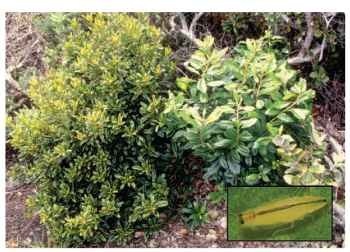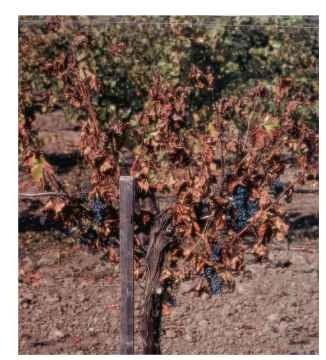Specialized Terms
phloem Plant vascular tissues that transport sugars and other nutrients.
xylem Plant vascular tissues that transport water and nutrients from the roots upward.
The feeding of insects and mites, especially those that suck fluids from plants, can cause symptoms of distress such as yellowing (chlorosis), silvering, bronzing or necrosis of foliage, wilting or discoloration of shoots, and malformation of leaves, stems, roots, fruits, and other plant organs or tissues. These symptoms may be confused with plant diseases caused by viruses or other plant pathogens.
DEFINITION AND IMPORTANCE
Insects damage plants in many ways, but the most common type of damage is the removal of plant tissues, as in the familiar examples of caterpillars, beetles, and grasshoppers whose feeding creates noticeable holes or even the wholesale removal of leaves, fruits, or other plant parts. Minute arthropods such as mites and thrips remove plant parts on a smaller scale by evacuating the contents of individual plant cells by their feeding. In contrast to damage caused by the removal of plant tissue, a phytotoxemia is the reaction of a plant to a chemical toxin introduced by insect feeding. Sucking insects in the order Hemiptera, such as plant bugs, aphids, leaf-hoppers, and psyllids, are the best-known insects that cause phy-totoxicity by their feeding (phytotoxemia). Examples of external phytotoxins include chemical air pollutants and pesticides. Abnormal plant growths or deformities called galls can be caused by certain insects (see Gallmaking and Insects).
The symptoms or appearance of insect phytoxemias are often very similar to symptoms caused by infections with plant viruses or other infectious microorganisms that cause plant disease. Phytotoxemias can be distinguished from diseases caused by pathogens by the following criteria: (1) the capacity of the insect to produce symptoms is characteristic of the species, not restricted to certain individuals within the species; (2) the incidence and severity of symptoms are directly related to the number of insects (even where a single insect may cause symptoms) and the amount of time spent feeding; and (3) plants recover at least partly from further development of symptoms when the insects are removed. In contrast, plant viruses transmitted by insect vectors (see Plant Diseases and Insects) are not present in all individuals in a vector species; each individual must acquire or inherit the virus. Furthermore, plants develop symptoms of viral disease as a result of infection introduced by a single vector insect that might have transmitted the virus to the plant. Finally, plants will not recover from virus diseases because of the removal of vectors from the plant.
The appearance of a phytotoxemia can be small, localized lesions of discolored or dead (necrotic) tissue, the formation of cork, scabs or pits, premature fall of leaves or fruits, curling or malformation of plant organs. These are often symptoms of plant diseases caused by pathogenic microorganisms and thus may be easily confused with symptoms caused by pathogens. Symptoms may be systemic, that is far removed from the site of insect feeding. For example, leaves may be discolored or distorted by phytotoxic feeding in roots or stems.
EXAMPLES AND CAUSES OF INSECT PHYTOTOXICITY
The causes of phytoxemias are not well understood. Mechanical damage to plant tissues caused by sucking insects is not as easy to observe as for chewing insects because the damage occurs at the cellular level and is internal. Hopperburn is a condition caused in a variety of plants by small leafhoppers (family Cicadellidae) in the genus Empoasca. The most widely studied type of hopperburn is in alfalfa caused by the potato leafhopper Empoasca fabae. Laceration of the vascular tissues of the plant disrupts the flow of water and plant sap to leaves, but there is also evidence that chemicals within the leafhoppers’ saliva induce yellowing and necrosis typical of hopperburn. Simulation of leaf-hopper feeding with a fine needle causes some but not all symptoms of hopperburn. Introducing crushed salivary glands of the potato leafhopper more closely simulates hopperburn. Other species of Empoasca cause hopperburn in beans in South America (E. kreameri) and grapes in Europe and North Africa (E. lybica). The phytotoxicity of the leafhopper Sophonia rufofascia, which became established in Hawaii in the 1980s, caused extensive damage to many native plants in Hawaii, threatening the continued survival of some rare species. Its phytotoxicity is similar in many respects to hopper-burn: halted growth and necrosis in some plants, yellowing of leaf tissues, and stunting of new growth in other plants (Fig. 1).
The grape phylloxera (Daktulosphaira vitifoliae) is a devastating pest of grapevines that wrecked millions of hectares of European vineyards in the 19th century and continues to be a serious pest of vines worldwide. The aphid-like phylloxera have a complex life cycle, with some forms (gallicoles) causing galls on leaves, and other forms (radicoles) causing galls and necrosis in roots. Phylloxera damage to roots kills European vines unless they are grafted onto rootstocks of wild grape species native to North America or onto hybrids of tolerant wild species (Fig. 2). Resistant grape species may have fewer phylloxera on their roots than European grapes, but it is their tolerance of grape phylloxera infestation without damage that is the main basis of their usefulness in avoiding phylloxera phytotoxicity. Feeding damage causes small roots to develop deformities and also kills root cells just beneath the bark. Soil-inhabiting fungi that invade roots may promote the decline of phylloxera-damaged vines.
The feeding of the silverleaf whitefly (Bemisia argentifolii) causes silvering of the leaves of squash plants and reduces fruit size and color. Feeding also causes tomatoes to ripen more slowly than normal. Unidentified chemical components of whitefly saliva seem to be involved, but the plant’s reaction is genetically controlled. The potato

FIGURE 1 The myrtle bushes on the left (normal to right) are damaged by the feeding of the leafhopper Sophonia rufofascia (inset).

FIGURE 2 Dead grapevines attest to the severity of phylloxera feeding damage to roots. The healthy vines next to the declining vines have only the initial stages of phylloxera damage.
psyllid (Paratrioza cockerelli) causes a yellowing and stunting of potato and tomato called psyllid yellows, The immature stages rather than adults are most damaging. Because individual psyllids may vary markedly in their ability to cause damage and only a few psyllids are needed to cause symptoms, a virus was suspected to be involved in causing psyllid yellows but discounted because of the direct relationship between damage and the number of psyllids feeding on a plant and the disappearance of symptoms after removing the psyl-lids. However, the recent discovery of a bacterium (“Candidatus Liberibacter psyllaurous”) associated closely with the disease, may yet show that a pathogen is involved in casuing psyllid yellows.
Other insects that cause phytotoxemias include species of aphids, mealybugs, planthoppers, treehoppers, spittlebugs, mirid bugs, coreid bugs, and stink bugs. Blister or gall mites (family Eriophyidae) are also well known for inducing abnormal growth in many uncultivated plants as well as ornamentals and some crop plants.
